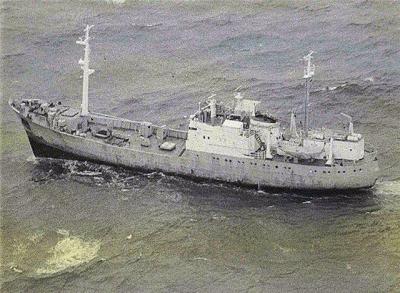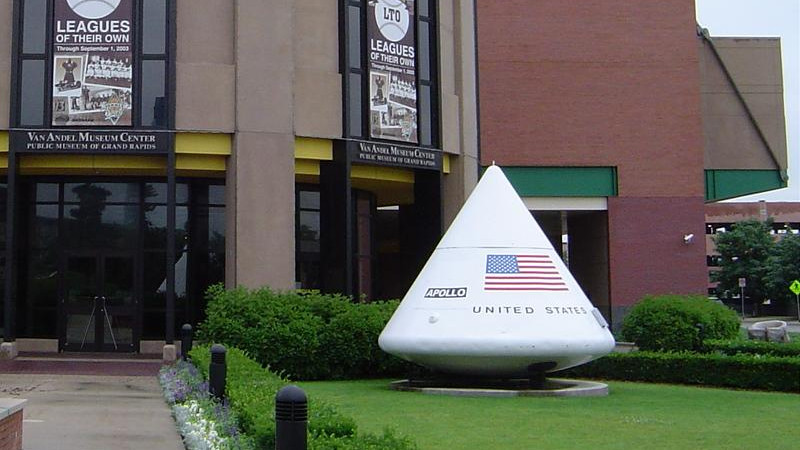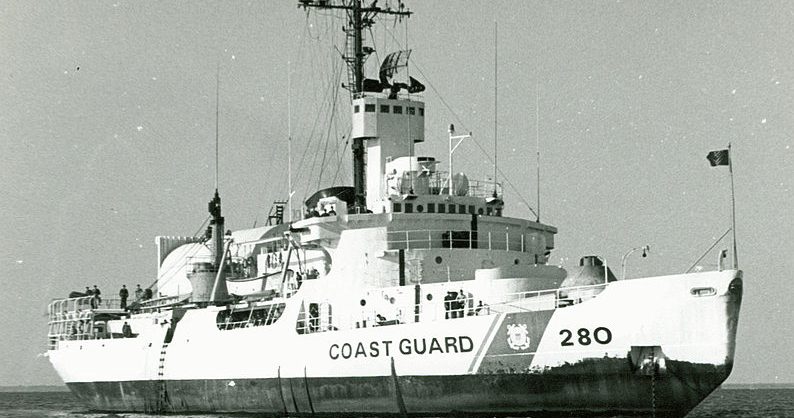There’s an Apollo module on display in Michigan and its cold-war backstory is even more interesting than its space program origins.
Everyone who visits the Van Andel Museum Center in Grand Rapids, Michigan is sure to see the Apollo Command Module flanking the front entrance. Right now it’s being used as a different kind of capsule: a time capsule they’ll open in 2076 (the American tricentennial). If you look close though, this isn’t an actual Command Module but what they call a “boilerplate.”
Technically, these were mass simulators made cheaply for certain tests and training purposes. A full spacecraft costs a lot of money but these — historically made out of boilerplate steel — could be made with just the pieces necessary and using less expensive materials. What you might not know is that the boilerplate at the Van Ardel — BP 1227 — has a cold war spy history unlike any other boilerplate in the fleet.
 The early life of BP 1227 is a little sketchy. It appears the Navy was using it for recovery training somewhere between the Azores and the Bay of Biscay in early 1969. We don’t know for sure if the picture to the left is BP 1227 or not. Comparing it to the one at the museum, it probably isn’t, but then again the museum’s does have a fresh paint job and possibly a top cap. Regardless, the picture to the left was from 1966 in the Atlantic, giving us an idea of how boilerplate capsules were put into service.
The early life of BP 1227 is a little sketchy. It appears the Navy was using it for recovery training somewhere between the Azores and the Bay of Biscay in early 1969. We don’t know for sure if the picture to the left is BP 1227 or not. Comparing it to the one at the museum, it probably isn’t, but then again the museum’s does have a fresh paint job and possibly a top cap. Regardless, the picture to the left was from 1966 in the Atlantic, giving us an idea of how boilerplate capsules were put into service.
In those days — the height of the cold war — Naval ships were often followed by Soviet “fishing trawlers.” These were universally understood to be spy ships — Auxiliary, General Intelligence or AGI vessels.
The AGI, the Navy, and a Capsule Lost
 AGI crews were highly trained, and after the Cuban missile crisis, the U. S. Navy had a program to actively discourage them by pushing against them, fouling their screws with steel nets, and focusing high power electromagnetic transmitters to burn out their electronic sensors. There were even cases of dumping ship’s garbage from a helo onto the decks of an AGI. Of course, the AGIs also crowded the U. S. ships and occasionally would strike them, so it wasn’t all one sided. This ended — for the most part — when both sides signed a treaty in 1972.
AGI crews were highly trained, and after the Cuban missile crisis, the U. S. Navy had a program to actively discourage them by pushing against them, fouling their screws with steel nets, and focusing high power electromagnetic transmitters to burn out their electronic sensors. There were even cases of dumping ship’s garbage from a helo onto the decks of an AGI. Of course, the AGIs also crowded the U. S. ships and occasionally would strike them, so it wasn’t all one sided. This ended — for the most part — when both sides signed a treaty in 1972.
However, in 1969, U. S. Navy ships often had AGI shadows. We don’t know the exact circumstances or if one or more AGIs were involved, but apparently BP 1227 was lost during those 1969 training exercises. It is a good bet that if an AGI was not involved in causing the loss, one or more did know exactly where the boilerplate capsule went down.
What Happened Next?
The is where the story goes cold for a while. There is a rumor that we know so little because the US and the Soviets agreed not to disclose some details of what happened until 2021 — which isn’t that far away. Here’s what we do know.
This is the Southwind, a US Coast Guard Wind-class icebreaker which was in the fleet for less than a year before the ship was given over to the Russians in 1945 as part of the Lend-Lease program. She was renamed the Admiral Makarov and joined Russia’s fleet for a brief five years before they gave her back and she became a US Navy ship, Atka.
In 1966, the Coast Guard got the ship back from the Navy and reverted the name to Southwind. You’re likely wondering why the long backstory on this ship. In 1970, is was the Southwind that became the first U. S. vessel to visit the Soviet Union since the end of World War II. The ship had an AGI escort, the whole way.
It docked at Murmansk where the crew took shore leave and the ship was open for public tours by Soviet citizens. The surprise, though, was when the Soviets presented Southwind with BP 1227 which had been found by a “fishing boat.” They lashed the faux capsule to the deck, and returned it to England. NASA eventually took possession and gave it to the Smithsonian. From there it was loaned for 100 years to the museum in Grand Rapids.
Spy Games
You can only speculate on why the Soviets would do this. It is doubtful they forcibly took the capsule, of course. We would guess it went under and they returned under better conditions and salvaged it. Why take the trouble? Maybe to say that they could. After all, the U. S. spent a lot of effort to temporarily steal a Lunik capsule that was also not a working flight article. You never know what information you could glean from something like that until you have it in your hands. You’d think the propaganda value alone would be good, but surprisingly, few people know the story of BP 1227. But now, you do.
Nearly 50 years later, with the Russians and the U. S. as major partners in the International Space Station it is hard to imagine that this kind of thing went on. You also have to wonder what a world space program with one direction and one massive budget could accomplish.
[Main image by Lisa Fessenden via A Field Guide to American Spacecraft]
















Just a quick typo correction, it’s the Van Andel (instead of Ardel).
If anyone is in the area and hasn’t been to this museum I highly recommend it, it’s actually really cool.
I think that would be the Van Andel Museum.
I caught that about the same time you guys were both posting. Thanks!
I’ve been inside of that one in Grand Rapids when I was a kid, before that museum was rename for Van Andel. (Van Andel and DeVos own that entire city. the arena, the hospitals, hotels, concert hall, the museum, …).
Surprised that ship wasn’t bugged to hell and back, like our embassy.
How do you know that it wasn’t? And also it could same way be ‘bugged’ before they gave it to Soviets, it works both way. I think it was the reason of returning this ship, just to be safe.
It was unlikely to have been bugged when it was given to the Soviets, because at that time the US and the USSR was allies fighting Nazi Germany (and Japan).
The US effectively gave enormous amounts of supplies and equipment to all of the Allied powers, being one of the only countries in the world with an advanced manufacturing capability that hadn’t been destroyed by years of war.
Try punctuation, it helps people understand what you’re trying to say. But it still needs more than punctuation to achieve that.
haha
“what a world space program with one direction and one massive budget could accomplish”: Considering how messed up NASA’s manned space flight program is these days, I think having politicians throw money at a space monopoly would be a very wasteful thing to do.
How messed up is it? Using the Russian Soyuz system seems like a pretty good idea.
I’m not sure if you’re being facetious, but I was referring to the boondoggle that is the Space Launch System.
What makes it a boondoggle?
“What makes it a boondoggle?”: The mission keeps changing, meaning they’ve wasted lots of money designing things and then abandoning them, it’s years behind schedule and way over budget, and when (if) it finally flies, it will be horribly expensive per flight and it’s likely to be obsolete because of SpaceX and (maybe) Blue Origin.
Well, Bob, SLS doesn’t have truckloads of money being thrown at it like Apollo. I think they are taking it more cautiously to get it right at every iteration. Yes, SpaceX may have a dependable launcher, but until it makes a return trip from Mars, it’s not ahead of the game.
Ren, I called SLS a boondoggle, so if you’re arguing that its problem is that it needs more money, you’ll have a hard time convincing me. You’ll also have a hard time convincing me that SLS’s difficulties are due to NASA “taking it more cautiously to get it right at every iteration”.
And remember, SLS is based on a lot of shuttle hardware. NASA would have more excuses if they were building a new system completely from scratch (like Musk and Bezos) but they’re not. And Musk is *still* beating them.
And SpaceX is absolutely ahead of the game. Falcon 9 has launched 50+ times, Falcon Heavy has launched once, and SLS has launched zero times. Some people compare SLS to FH and say SLS is “better” in some regards, but that’s the wrong comparison to make. The right comparison is SLS vs. Big Falcon Rocket. When (if) SLS launches, we can look at where BFR is and then we can discuss who is ahead of the game.
But I know who I’d put my money on (if I had a choice, which I don’t, because my gov’t is forcing me to put my money on SLS).
Oh, and now Trump wants a space station in lunar orbit. Why? Because the ISS has paid off so well, we want to spend 100 or 1,000 times as much on another one further away? Gaaahhh!!
It’s a terrible idea, when we have anything launched by a foreign organization we automatically become the junior partner in the experiments done with whatever is launched. This comes from an astronomer that gave a talk locally about this.
Yes, distrust in China!
B^)
That’s nothing. The CIA once recovered part of a lost Soviet nuclear sub in very deep water (while being watched by “fishing trawlers”).
https://en.wikipedia.org/wiki/Project_Azorian
You mean they weren’t mining manganese?
Ahh, yes. The Hughes “Glomar Explorer”, claimed to be contructed to harvest manganese nodules on the ocean floor, actually built to recover a lost soviet nuke boat.
Yeah, I have an issue of popular science that has an article about how the glomar explorer was going to suck these nodules up.
Well, I’m sure there was “some” manganese alloys in the sunken sub.
B^)
They actually did get manganese nodules. I happen to have one that was recovered. The manganese ‘mining’ was in effect before the sub raising and the secret program was hidden in it as it is better to hide in a real thing than a fake. Fakes can be figured out. As was done when the orange fake lobsters on a trawler gave away a boat.
The question that should be asked: what even more secret program was hidden in the sub-raising…
Speaking as an outsider, the whole space program ( USA, USSR/Russia, Europe, Japan, China etc etc, including ‘peep, peep, peep, poof’ North Korea) has been a great adventure. Keep up the pissing USA, the good has mitigated a lot of the bad.
Interesting read.
If you folks want to visit boiler plate Apollos there is one receiving its mail at the Navy flight museum in P’cola Florida. When I saw it in September 2008 it took me a few moments to figure out why it was there, and what it was built for.
There is one here in Houston at JSC along with a real one too.
They picked it up for a song?
B^)
Al, now that you’ve made your correction, you can delete my comment(s).
There’s one at the Museum of Life and Science in Durham, NC. Last time I saw it, it was lined with carpet inside and kids could play in it.
The capsule doesn’t look like it’s been burnt enough to have gone through a re-entry? Is it like the not accurately depicted nuclear bomb blast events magnitude disinformation?
It didn’t. It was a boilerplate test article, not a real capsule. If you look at the one at JSC you can clearly see where the ablative burned off on reentry. You can also tell it is made of different materials.
It may have not been through launch or re-entry. But dropped from an aircraft to test buoyancy and/or train Navy recovery teams.
Thanks for clarification gentlemen. I’ve never heard of the term “biolerplate” and didn’t read into more.
Nobody reads the boilerplate, dont worry
“Nearly 50 years later, with the Russians and the U. S. as major partners in the International Space Station it is hard to imagine that this kind of thing went on.”
Uh, no, it’s not that hard to imagine today. Have you heard of the repeated games Russia plays to this day? Skimming sensitive areas with nuclear bombers, buzzing carriers, having agents break into the rooms of American diplomats only to take a dump on the floor. Russia never stopped playing cold war games. I sincerely doubt they’ve stopped trying to gather intelligence on US space capabilities.
I’ve worked with Roscosmos many many times and have a lot of respect for my Russian colleagues’ technical expertise, practicality, and depth of experience. I’m sure our government does a lot of oddball things too, but we were always more interested in astronaut/cosmonaut safety and furthering man’s ability to explore space.
Talk about taking in way more communist and other expats that didn’t help make anything healthier, safer, well fare, well being and sane. Let’s just remove walls from our residences and be naked with RF/Microwave beams to keep us warm and hair pinned.
The U.S. military pisses away thousands of times more money than NASA. Get your priorities straight.
You also have to wonder what a world space program with one direction and one massive budget could accomplish.
A lot less. See EASA for examples. At least having two, you induce a rivalry and get things done faster. Competition drives people.
I’ve worked with ESA, too. Given their budget, they do quite a bit. I think, though — personal opinion — they see their role as doing something different. They don’t want to say “Oh the US and the Russians and the Chinese did this, so we’re going to do it too!” They look for opportunities to be original and I think they succeed at that very well. They don’t really publicize as much as some of the other agencies, but if you are ever in Amsterdam or Haarlem or that area, take a pleasant drive to nearby Noordwijk (beautiful little beach town worth the drive anyway) and visit ESTL. You might be surprised at all the things ESA has done.
Rosetta and Philae come to mind. Giotto, Huygens… plenty more.
I live near GR, and never knew the history of that capsule. My favorite part of the Grand Rapids Public Museum is their Corliss steam engine. Their furniture shop and demonstrations are pretty cool as well.
There was a place outside of Tucson Az back in the 70’s, Surplus AIrcraft, that had a training capsule for a while. I recall as a teen being amazed at a couple of things. One was how cramped it was in there, and the other was how much of the electronics etc was taken from aircraft. Also at least in this one, some of the switches and things had dymo and sharpie labels on them.
I think the place is gone now. It was by far the coolest surplus place I had ever visited and the owner was always nice to younger folks. You could go in with a few bucks and he would find something fun for you to play with out in the back nine. I should mention that the business was in a hanger, or the good stuff was in a hanger, he had rows of industrial shelving out back, and than what seemed like acres of just stuff out past the shelves. Anybody live out that way and remember the place?